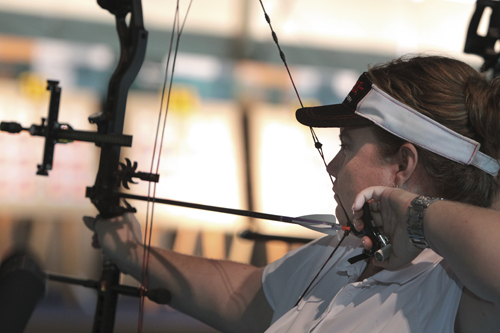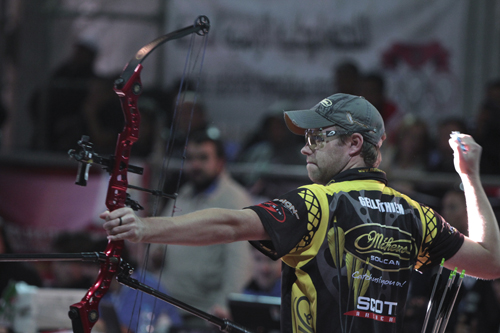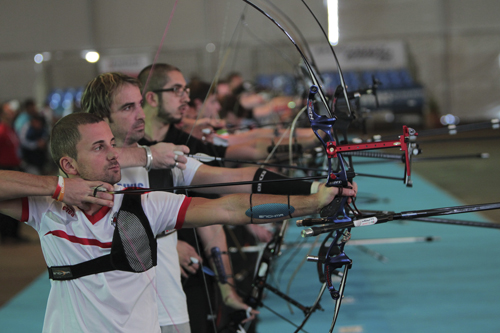Roy Rose knows an unanticipated release is essential – and here, he explains why
One of the most puzzling aspects of our sport is surely the statistic that reveals that, although almost every elite shooter employs a surprise release, with just a very few exceptions, the average club shooter in most cases does the exact opposite, and commands the shot. I see this most often in the case of compound archers with a wrist-style finger trigger release, though archers of all disciplines and equipment can struggle with it. A further statistical study also shows that a good percentage of these shooters not only fail to achieve repetitive accuracy, they are also prone to various types of target panic, which is a primary reason so many are lost to our sport.
However, it seems no matter how much the statistics are brought to our attention, the percentages continue to hold steady. This means that the failure to achieve consistent accuracy – the obvious goal of any archer – and even more alarmingly, the departure in frustration from a sport which can be a healthy and rewarding lifetime activity, remain the final outcomes.
Clearly, unanticipated processing of a shot through a clicker or release aid is an absolute necessity if one wishes to excel in either the recurve or compound disciplines. The solution would seem to be relatively simple; if coaches and club leaders were to teach the correct use of the release aid from the very outset, rather than have newcomers being led to believe we simply aim, then depress the trigger, it would greatly reduce the number of archers who struggle to learn it later on. Perhaps even the term ‘trigger’ is in itself a term open to question.
So although experienced archers are aware of the dangers of commanding the shot, it does seem that the probable outcomes, namely inaccuracy and target dilemmas or, at worst, departure from the sport in frustration, don’t seem to impact on the thinking of the archery newcomer. Perhaps this is because the end results, although outlined, don’t actually present any explanation as to why unanticipated processing is, in fact, crucial.So why is the unanticipated, surprise releasing of the arrow from the bow such a big deal?
So why is the unanticipated, surprise releasing of the arrow from the bow such a big deal?
The critical reason why is inherent in our physical and mental makeup, and is defined by the sporting exercise physiologies as IBF – the impact bracing factor. So what is IBF and how does it affect our shooting process?
As we are all very aware, any time we are subjected to any possible impact upon our person our reflex, mentally and physically, is to brace ourselves in an attempt to cushion whatever force is coming against us. It may be a bracing action in response to a punch being thrown, it may be putting out an arm to compensate for an impending fall, it can be any one of a myriad of circumstances. This action is what is termed as an impact bracing factor, and it happens completely naturally. So clearly if any archer is at full draw, holding poundage, focused on aim, and the brain is fully aware of the fact that the release of that arrow is going to impact the physical welfare of the shooter, this must produce an impediment to retaining composure and aim, free from a flinch or compensating physical reaction. Employing a surprise release logically allows the arrow to depart the bow before the brain can bring the impact bracing factor into play.
The clicker on the recurve bow not only provides a tension and draw check, it allows the archer to release immediately the sound of the clicker striking the plate occurs. It may well be argued that this situation is perhaps somewhat less spontaneous, and therefore less conclusively a surprise, than the break of a release on a compound, but nonetheless it has a major nullifying effect on IBF for the recurve archer.
And this is the shot process used universally by the world’s elite recurve shooters, all of whom employ a clicker. My respect for barebow and longbow archers, often the unheralded champions of our sport, has always been at an escalated level, because these archers must learn to function without the aids to unanticipated processing, and thus learn to contend as much as is humanely possible with IBF, as well as the lack of a specific sighting mechanism.
The compound archer who commands the shot leaves him- or herself open to the impact of IBF, along with all the other nasties likely to eventuate in aiming maladies. If the archer makes a conscious decision to initiate the shot, then immediately that shooter opens the door to their mental and physical faculties to react to that impending force of release. This will manifest itself as flinching, and puts one on the road to aiming hassles and punching of the trigger and, in the worst case scenario, utter frustration, and often departure from the archery scene, which is a sad and unnecessary predicament.
It is also a verified statistic that those archers who are instructed correctly from day one on the proper use of a compound release aid almost universally do not experience target panic situations during their shooting future. Unfortunately, the archer who comes to compound processing by aiming and then depressing a light trigger can experience some acceptable accuracy, but impending panic situations are almost always assured, and it is not a nice place to any aspiring shooter to find themselves.

Teaching good release aid technique early on will help prevent trigger-punching habits forming, and can even prevent target panic
Use of a thumb or an index finger trigger release simply requires the setting of a trigger tension that is compatible with the archer being able to put a positive placement on the post, without the release firing, then aim, and apply scapula motion until the release fires. In the case of the hinge jaw release, which is devoid of a trigger, the release fires by rotation by means of, once again, scapula motion past the click, or pressure applied to the ring finger side of the hand.
There is no question that in order to defeat the body’s impact bracing factor, to bypass the scourge of target panic issues, and avoid the possible disastrous loss of a potential long-term archer from our ranks, that coaches and fellow experienced club shooters should introduce newcomers to the fold to the correct use of the release aid in an unanticipated manner, and encourage new recurve archers to fit a clicker. If this were done universally then both accuracy satisfaction, and departure from our sport prematurely, could be situations resolved in the positive, and allow archers one and all to be the best they can be.



